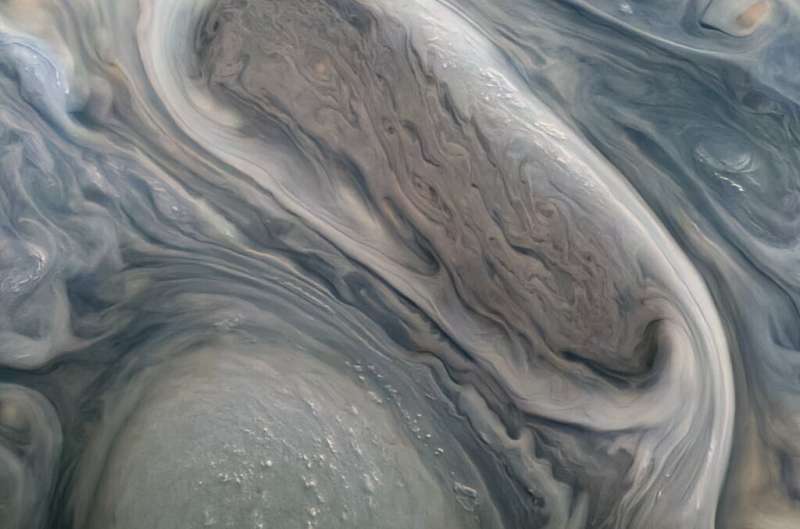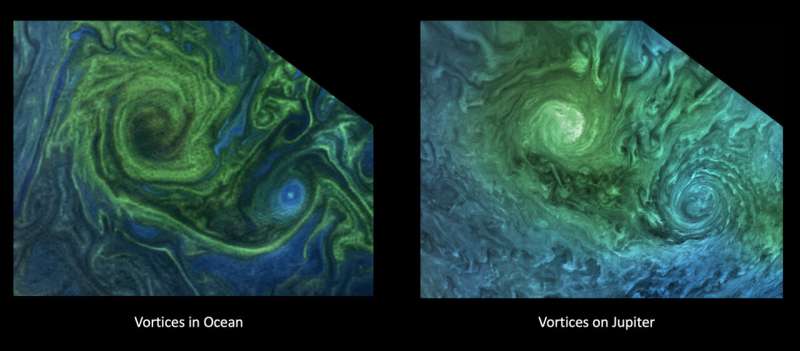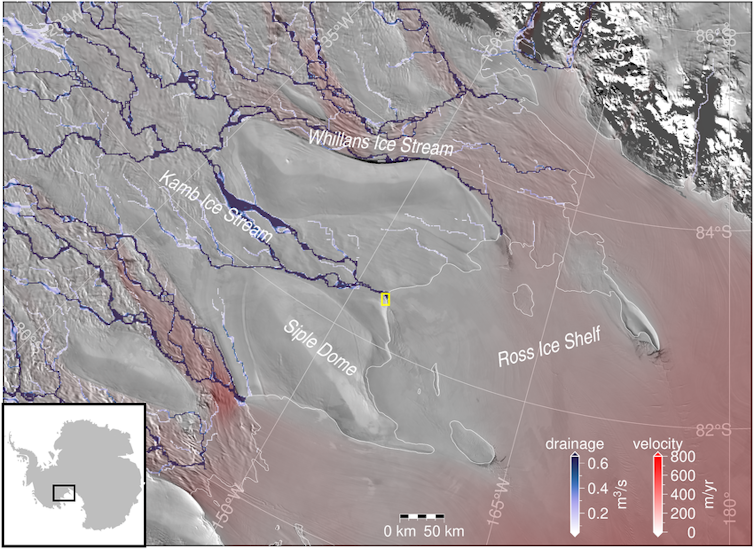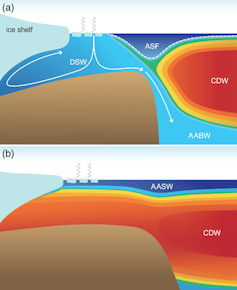Science
Juno spacecraft 'hears' Jupiter's moon – Phys.org

Sounds from a Ganymede flyby, magnetic fields, and remarkable comparisons between Jupiter and Earth’s oceans and atmospheres were discussed during a briefing today on NASA’s Juno mission to Jupiter at the American Geophysical Union Fall Meeting in New Orleans.
Juno Principal Investigator Scott Bolton of the Southwest Research Institute in San Antonio has debuted a 50-second audio track generated from data collected during the mission’s close flyby of the Jovian moon Ganymede on June 7, 2021. Juno’s Waves instrument, which tunes in to electric and magnetic radio waves produced in Jupiter’s magnetosphere, collected the data on those emissions. Their frequency was then shifted into the audio range to make the audio track.
“This soundtrack is just wild enough to make you feel as if you were riding along as Juno sails past Ganymede for the first time in more than two decades,” said Bolton. “If you listen closely, you can hear the abrupt change to higher frequencies around the midpoint of the recording, which represents entry into a different region in Ganymede’s magnetosphere.”
Detailed analysis and modeling of the Waves data are ongoing. “It is possible the change in the frequency shortly after closest approach is due to passing from the nightside to the dayside of Ganymede,” said William Kurth of the University of Iowa in Iowa City, lead co-investigator for the Waves investigation.
At the time of Juno’s closest approach to Ganymede—during the mission’s 34th trip around Jupiter—the spacecraft was within 645 miles (1,038 kilometers) of the moon’s surface and traveling at a relative velocity of 41,600 mph (67,000 kph).
[embedded content]
Magnetic Jupiter
Jack Connerney from NASA’s Goddard Space Flight Center in Greenbelt, Maryland, is the lead investigator with Juno’s magnetometer and is the mission’s deputy principal investigator. His team has produced the most detailed map ever obtained of Jupiter’s magnetic field.
Compiled from data collected from 32 orbits during Juno’s prime mission, the map provides new insights into the gas giant’s mysterious Great Blue Spot, a magnetic anomaly at the planet’s equator. Juno data indicates that a change in the gas giant’s magnetic field has occurred during the spacecraft’s five years in orbit, and that the Great Blue Spot is drifting eastward at a speed of about 2 inches (4 centimeters) per second relative to the rest of Jupiter’s interior, lapping the planet in about 350 years.
In contrast, the Great Red Spot—the long-lived atmospheric anticyclone just south of Jupiter’s equator—is drifting westward at a relatively rapid clip, circling the planet in about four-and-a-half years.
In addition, the new map shows that Jupiter’s zonal winds (jet streams that run east to west and west to east, giving Jupiter’s its distinctive banded appearance) are pulling the Great Blue Spot apart. This means that the zonal winds measured on the surface of the planet reach deep into the planet’s interior.
The new magnetic field map also allows Juno scientists to make comparisons with Earth’s magnetic field. The data suggests to the team that dynamo action—the mechanism by which a celestial body generates a magnetic field—in Jupiter’s interior occurs in metallic hydrogen, beneath a layer expressing “helium rain.”
Data Juno collects during its extended mission may further unravel the mysteries of the dynamo effect not only at Jupiter but those of other planets, including Earth.


Earth’s Oceans, Jupiter’s Atmosphere
Lia Siegelman, a physical oceanographer and postdoctoral fellow at Scripps Institution of Oceanography at the University of California, San Diego, decided to study the dynamics of Jupiter’s atmosphere after noticing that the cyclones at Jupiter’s pole appear to share similarities with ocean vortices she studied during her time as a doctoral student.
“When I saw the richness of the turbulence around the Jovian cyclones, with all the filaments and smaller eddies, it reminded me of the turbulence you see in the ocean around eddies,” said Siegelman. “These are especially evident in high-resolution satellite images of vortices in Earth’s oceans that are revealed by plankton blooms that act as tracers of the flow.”
The simplified model of Jupiter’s pole shows that geometric patterns of vortices, like those observed on Jupiter, spontaneously emerge, and survive forever. This means that the basic geometrical configuration of the planet allows these intriguing structures to form.
Although Jupiter’s energy system is on a scale much larger than Earth’s, understanding the dynamics of the Jovian atmosphere could help us understand the physical mechanisms at play on our own planet.
Arming Perseus
The Juno team has also released its latest image of Jupiter’s faint dust ring, taken from inside the ring looking out by the spacecraft’s Stellar Reference Unit navigation camera. The brightest of the thin bands and neighboring dark regions scene in the image are linked to dust generated by two of Jupiter’s small moons, Metis and Adrastea. The image also captures the arm of the constellation Perseus.
“It is breathtaking that we can gaze at these familiar constellations from a spacecraft a half-billion miles away,” said Heidi Becker, lead co-investigator of Juno’s Stellar Reference Unit instrument at NASA’s Jet Propulsion Laboratory in Pasadena. “But everything looks pretty much the same as when we appreciate them from our backyards here on Earth. It’s an awe-inspiring reminder of how small we are and how much there is left to explore.”
Explore further
Spacecraft buzzes Jupiter’s mega moon, 1st close-up in years
Citation:
Juno spacecraft ‘hears’ Jupiter’s moon (2021, December 17)
retrieved 18 December 2021
from https://phys.org/news/2021-12-juno-spacecraft-jupiter-moon.html
This document is subject to copyright. Apart from any fair dealing for the purpose of private study or research, no
part may be reproduced without the written permission. The content is provided for information purposes only.
Science
"Hi, It's Me": NASA's Voyager 1 Phones Home From 15 Billion Miles Away – NDTV


<!–
Launched in 1977, Voyager 1 was mankind’s first spacecraft to enter the interstellar medium
Washington, United States:
NASA’s Voyager 1 probe — the most distant man-made object in the universe — is returning usable information to ground control following months of spouting gibberish, the US space agency announced Monday.
The spaceship stopped sending readable data back to Earth on November 14, 2023, even though controllers could tell it was still receiving their commands.
In March, teams working at NASA’s Jet Propulsion Laboratory discovered that a single malfunctioning chip was to blame, and devised a clever coding fix that worked within the tight memory constraints of its 46-year-old computer system.
window._rrCode = window._rrCode || [];_rrCode.push(function() (function(v,d,o,ai)ai=d.createElement(“script”);ai.defer=true;ai.async=true;ai.src=v.location.protocol+o;d.head.appendChild(ai);)(window, document, “//a.vdo.ai/core/v-ndtv/vdo.ai.js”); );
“Voyager 1 spacecraft is returning usable data about the health and status of its onboard engineering systems,” the agency said.
Hi, it’s me. – V1 https://t.co/jgGFBfxIOe
— NASA Voyager (@NASAVoyager) April 22, 2024
“The next step is to enable the spacecraft to begin returning science data again.”
Launched in 1977, Voyager 1 was mankind’s first spacecraft to enter the interstellar medium, in 2012, and is currently more than 15 billion miles from Earth. Messages sent from Earth take about 22.5 hours to reach the spacecraft.
Its twin, Voyager 2, also left the solar system in 2018.
Both Voyager spacecraft carry “Golden Records” — 12-inch, gold-plated copper disks intended to convey the story of our world to extraterrestrials.
These include a map of our solar system, a piece of uranium that serves as a radioactive clock allowing recipients to date the spaceship’s launch, and symbolic instructions that convey how to play the record.
The contents of the record, selected for NASA by a committee chaired by legendary astronomer Carl Sagan, include encoded images of life on Earth, as well as music and sounds that can be played using an included stylus.
window._rrCode = window._rrCode || [];_rrCode.push(function(){ (function(d,t) var s=d.createElement(t); var s1=d.createElement(t); if (d.getElementById(‘jsw-init’)) return; s.setAttribute(‘id’,’jsw-init’); s.setAttribute(‘src’,’https://www.jiosaavn.com/embed/_s/embed.js?ver=’+Date.now()); s.onload=function()document.getElementById(‘jads’).style.display=’block’;s1.appendChild(d.createTextNode(‘JioSaavnEmbedWidget.init(a:”1″, q:”1″, embed_src:”https://www.jiosaavn.com/embed/playlist/85481065″,”dfp_medium” : “1”,partner_id: “ndtv”);’));d.body.appendChild(s1);; if (document.readyState === ‘complete’) d.body.appendChild(s); else if (document.readyState === ‘loading’) var interval = setInterval(function() if(document.readyState === ‘complete’) d.body.appendChild(s); clearInterval(interval); , 100); else window.onload = function() d.body.appendChild(s); ; )(document,’script’); });
Their power banks are expected to be depleted sometime after 2025. They will then continue to wander the Milky Way, potentially for eternity, in silence.
(Except for the headline, this story has not been edited by NDTV staff and is published from a syndicated feed.)
Science
West Antarctica's ice sheet was smaller thousands of years ago – here's why this matters today – The Conversation


As the climate warms and Antarctica’s glaciers and ice sheets melt, the resulting rise in sea level has the potential to displace hundreds of millions of people around the world by the end of this century.
A key uncertainty in how much and how fast the seas will rise lies in whether currently “stable” parts of the West Antarctic Ice Sheet can become “unstable”.
One such region is West Antarctica’s Siple Coast, where rivers of ice flow off the continent and drain into the ocean.
Journal of Geophysical Research, CC BY-SA
This ice flow is slowed down by the Ross Ice Shelf, a floating mass of ice nearly the size of Spain, which holds back the land-based ice. Compared to other ice shelves in West Antarctica, the Ross Ice Shelf has little melting at its base because the ocean below it is very cold.
Although this region has been stable during the past few decades, recent research suggest this was not always the case. Radiocarbon dating of sediments from beneath the ice sheet tells us that it retreated hundreds of kilometres some 7,000 years ago, and then advanced again to its present position within the last 2,000 years.
Figuring out why this happened can help us better predict how the ice sheet will change in the future. In our new research, we test two main hypotheses.
Read more:
What an ocean hidden under Antarctic ice reveals about our planet’s future climate
Testing scenarios
Scientists have considered two possible explanations for this past ice sheet retreat and advance. The first is related to Earth’s crust below the ice sheet.
As an ice sheet shrinks, the change in ice mass causes the Earth’s crust to slowly uplift in response. At the same time, and counterintuitively, the sea level drops near the ice because of a weakening of the gravitational attraction between the ice sheet and the ocean water.
As the ice sheet thinned and retreated since the last ice age, crustal uplift and the fall in sea level in the region may have re-grounded floating ice, causing ice sheet advance.

AGU, CC BY-SA
The other hypothesis is that the ice sheet behaviour may be due to changes in the ocean. When the surface of the ocean freezes, forming sea ice, it expels salt into the water layers below. This cold briny water is heavier and mixes deep into the ocean, including under the Ross Ice Shelf. This blocks warm ocean currents from melting the ice.

AGU, CC BY-SA
Seafloor sediments and ice cores tell us that this deep mixing was weaker in the past when the ice sheet was retreating. This means that warm ocean currents may have flowed underneath the ice shelf and melted the ice. Mixing increased when the ice sheet was advancing.
We test these two ideas with computer model simulations of ice sheet flow and Earth’s crustal and sea surface responses to changes in the ice sheet with varying ocean temperature.
Because the rate of crustal uplift depends on the viscosity (stickiness) of the underlying mantle, we ran simulations within ranges estimated for West Antarctica. A stickier mantle means slower crustal uplift as the ice sheet thins.
The simulations that best matched geological records had a stickier mantle and a warmer ocean as the ice sheet retreated. In these simulations, the ice sheet retreats more quickly as the ocean warms.
When the ocean cools, the simulated ice sheet readvances to its present-day position. This means that changes in ocean temperature best explain the past ice sheet behaviour, but the rate of crustal uplift also affects how sensitive the ice sheet is to the ocean.

Veronika Meduna, CC BY-SA
What this means for climate policy today
Much attention has been paid to recent studies that show glacial melting may be irreversible in some parts of West Antarctica, such as the Amundsen Sea embayment.
In the context of such studies, policy debates hinge on whether we should focus on adapting to rising seas rather than cutting greenhouse gas emissions. If the ice sheet is already melting, are we too late for mitigation?
Our study suggests it is premature to give up on mitigation.
Global climate models run under high-emissions scenarios show less sea ice formation and deep ocean mixing. This could lead to the same cold-to-warm ocean switch that caused extensive ice sheet retreat thousands of years ago.
For West Antarctica’s Siple Coast, it is better if we prevent this ocean warming from occurring in the first place, which is still possible if we choose a low-emissions future.
Science
NASA's Voyager 1 resumes sending engineering updates to Earth – Phys.org


For the first time since November, NASA’s Voyager 1 spacecraft is returning usable data about the health and status of its onboard engineering systems. The next step is to enable the spacecraft to begin returning science data again. The probe and its twin, Voyager 2, are the only spacecraft to ever fly in interstellar space (the space between stars).
Voyager 1 stopped sending readable science and engineering data back to Earth on Nov. 14, 2023, even though mission controllers could tell the spacecraft was still receiving their commands and otherwise operating normally. In March, the Voyager engineering team at NASA’s Jet Propulsion Laboratory in Southern California confirmed that the issue was tied to one of the spacecraft’s three onboard computers, called the flight data subsystem (FDS). The FDS is responsible for packaging the science and engineering data before it’s sent to Earth.
The team discovered that a single chip responsible for storing a portion of the FDS memory—including some of the FDS computer’s software code—isn’t working. The loss of that code rendered the science and engineering data unusable. Unable to repair the chip, the team decided to place the affected code elsewhere in the FDS memory. But no single location is large enough to hold the section of code in its entirety.
So they devised a plan to divide affected the code into sections and store those sections in different places in the FDS. To make this plan work, they also needed to adjust those code sections to ensure, for example, that they all still function as a whole. Any references to the location of that code in other parts of the FDS memory needed to be updated as well.


The team started by singling out the code responsible for packaging the spacecraft’s engineering data. They sent it to its new location in the FDS memory on April 18. A radio signal takes about 22.5 hours to reach Voyager 1, which is over 15 billion miles (24 billion kilometers) from Earth, and another 22.5 hours for a signal to come back to Earth. When the mission flight team heard back from the spacecraft on April 20, they saw that the modification had worked: For the first time in five months, they have been able to check the health and status of the spacecraft.
During the coming weeks, the team will relocate and adjust the other affected portions of the FDS software. These include the portions that will start returning science data.
Voyager 2 continues to operate normally. Launched over 46 years ago, the twin Voyager spacecraft are the longest-running and most distant spacecraft in history. Before the start of their interstellar exploration, both probes flew by Saturn and Jupiter, and Voyager 2 flew by Uranus and Neptune.
Provided by
NASA
Citation:
NASA’s Voyager 1 resumes sending engineering updates to Earth (2024, April 22)
retrieved 22 April 2024
from https://phys.org/news/2024-04-nasa-voyager-resumes-earth.html
This document is subject to copyright. Apart from any fair dealing for the purpose of private study or research, no
part may be reproduced without the written permission. The content is provided for information purposes only.
-
Business19 hours ago
Honda to build electric vehicles and battery plant in Ontario, sources say – Global News
-



 Science20 hours ago
Science20 hours agoWill We Know if TRAPPIST-1e has Life? – Universe Today
-
Investment23 hours ago
Down 80%, Is Carnival Stock a Once-in-a-Generation Investment Opportunity?
-



 Health19 hours ago
Health19 hours agoSimcoe-Muskoka health unit urges residents to get immunized
-



 Health16 hours ago
Health16 hours agoSee how chicken farmers are trying to stop the spread of bird flu – Fox 46 Charlotte
-



 Investment18 hours ago
Investment18 hours agoOwn a cottage or investment property? Here's how to navigate the new capital gains tax changes – The Globe and Mail
-
News23 hours ago
Can Canada have an effective climate action policy without a carbon tax?
-



 Tech23 hours ago
Tech23 hours agoIndigenous Craft and Vendors Market a success in Halifax





